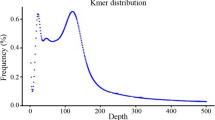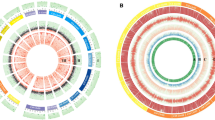Abstract
Crocus sativus L. is a sterile species (3n) whose origin has not been yet clarified. A lot of morphological studies supported the theory that it would have been originated from the evolution, or the hybridization, of other Crocus exemplars, especially C. thomasii, C. hadriaticus and C. cartwrightianus. Crocus sativus stigmas are saffron raw source but, because of their high economic value, sometimes this spice is adulterated. By the application of the DNA barcode technique, we analyzed different Crocus species genomes and we partially clarified some aspects of the phylogeny of this genus: in particular, C. sativus possible genetic derivation was elucidated. Our results also showed that different C. sativus species might have evolved by independent events, probably due to several geographical pressures. We demonstrated that barcoding method, usually adopted for interspecific taxonomic identification, could be also applied to intraspecific and population studies. Finally, we proposed this molecular approach as scientific tool able to discriminate and certificate saffron authenticity.


Similar content being viewed by others
References
Abdullaev FI, Espinosa J, Aguirre J (2004) Biomedical properties of saffron and its potential use in cancer therapy and chemoprevention trials. Cancer Detect Prev 28:426–432
Caballero-Ortega H, Pereda-Miranda R, Abdullaev FI (2007) HPLC quantification of major active components from 11 different saffron (Crocus sativus L.) sources. Food Chem 100:1126–1131
Carmona M, Alonso GL (2003) Advances in the control of saffron quality. The 1st International Symposium on saffron Biology and Biotechnology, Albacete, España, pp 26–27
Chichiriccò G (1999) Sterility and perspectives for genetic improvement of Crocus sativus L. In: Negbi M (ed) Saffron. Harwood Academic Publisher, Amsterdam, pp 127–135
Efron B, Tibshirani R (1986) Bootstrap methods for standard errors, confidence intervals, and other measures of statistical accuracy. Stat Sci 1(1):54–77
Gismondi A, Rolfo MF, Leonardi D, Rickards O, Canini A (2012) Identification of ancient Olea europaea L. and Cornus mas L. seeds by DNA barcode. C R Biologies 335:472–479
Gresta F (2007) Saffron, an alternative crop for sustainable agricultural systems. A review. Agron Sustain Dev 28:95–112
Grilli Caiola M (2004) Saffron reproductive biology. Acta Hort 650:25–37
Grilli Caiola M (2005) Embryo origin and development in Crocus sativus L. (Iridaceae). Plant Biosyst 139:335–343
Grilli Caiola M, Canini A (2010) Looking for saffron’s (Crocus sativus L.) parents. Func Plant Sci Biotech 4(2):1–14
Gugerli F, Parducci L, Petit RJ (2005) Ancient plant DNA: review and prospects. New Phytol 166:409–418
Guo X, Wang X, Su W, Zhang G, Zhou R (2011) DNA barcodes for discriminating the medicinal plant Scutellaria baicalensis (Lamiaceae) and its adulterants. Biol Pharm Bull 34(8):1198–1203
ISO/Technical Specification 3632 (2003) http://www.iso.org/iso/iso_catalogue/catalogue_ics/catalogue_detail_ics.htm?ics1=67&ics2=220&ics3=10&csnumber=44523(44526)
Javanmardi N, Bagheri A, Moshtaghi N, Sharifi A, Kakhki AH (2011) Identification of Safflower as a fraud in commercial Saffron using RAPD/SCAR marker. J Cell and Mol Res 3(1):31–37
Kress WJ, Erickson DL (2007) A two-locus global DNA barcode for land plants: the coding rbcL gene complements the non-coding trnH-psbA spacer region. PLoS ONE 6(e508):1–10
Kress WJ, Erickson DL (2008) DNA barcodes: genes, genomics, and bioinformatics. Proc Natl Acad Sci USA 105:2761–2762
Kumar S, Kahlon T, Chaudhary S (2011) A rapid screening for adulterants in olive oil using DNA barcodes. Food Chem 3:1335–1341
Lonzano P, Castellar MR, Simancas MJ, Ibora JL (1999) A quantitative high-performance liquid chromatographic method to analyze commercial saffron (Crocus sativus L.) products. J Chromatogr 830:477–483
Maish JM (1885) On the adulteration of saffron. The Analyst, pp 200–203
Mathew B (1982) The crocuses: a revision of the genus Crocus (Iridaceous). B T Batsford, London
Negbi M (1999) Saffron cultivation: past, present and future prospects. In: Negbi M (ed) Saffron Crocus sativus L. Harwood Academic Publishers, Amsterdam, pp 1–19
Petersen G, Seberg O, Thorsøe S, Jørgensen T, Mathew B (2008) A phylogeny of the genus Crocus (Iridaceae) based on sequence data from five plastidial regions. Taxon 57(2):487–499
Sabatino L, Scordino M, Gargano M, Belligno A, Traulo P, Gagliano G (2011) HPLC/PDA/ESI-MS evaluation of saffron (Crocus sativus L.) adulteration. Nat Prod Commun 6(12):1873–1876
Sampathu SR, Shivashankar S, Lewis YS (1984) Saffron (Crocus sativus L.): cultivation, processing, chemistry and standardization. Crit Rev Food Sci Nutr 20:123–157
Sano K, Himeno H (1987) In vitro proliferation of saffron (Crocus sativus L.) stigma. Plant Cell Tissue and Organ Cult 11:159–166
Seberg O, Petersen G (2009) How Many Loci Does it Take to DNA Barcode a Crocus? PLoS ONE 4(2):e4598. doi:10.1371/journal.pone.0004598
Shneer VS (2009) DNA barcoding is a new approach in comparative genomics of plants. Genetika 45:1436–1448
Tavakkol-Afshari J, Brook A, Mousavi SH (2008) Study of cytotoxic and apoptogenic properties of saffron extract in human cancer cell lines. Food and Chem Tox 46:3443–3447
Templeton AR, Crandall KA, Sing CF (1992) A cladistic analysis of phenotypic associations with haplotypes inferred from restriction endonuclease mapping and DNA sequence data III. Cladogram estimation. Genetics 132:619–633
Yao H, Song JY, Ma XY, Liu C, Li Y, Xu HX, Han JP, Duan LS, Chen SL (2009) Identification of Dendrobium species by a candidate DNA barcode sequence: the chloroplast psbA-trnH intergenic region. Planta Med 75:667–669
Zalacain A, Ordoudi SA, Diaz-Plaza EM, Carmona M, Blazquez I, Tsimidou MZ, Alonso GL (2005) Near-infrared spectroscopy in saffron quality control: determination of chemical composition and geographical origin. J Agr Food Chem 53:9337–9341
Author information
Authors and Affiliations
Corresponding author
Electronic supplementary material
Below is the link to the electronic supplementary material.
606_2013_841_MOESM1_ESM.doc
Electronic supplementary material 1 Lists of accessions, registered in NCBI (Nucleotide Scientific Databank, http://www.ncbi.nlm.nih.gov/nuccore) that matched with nucleotide sequence obtained by ITS barcode gene PCR amplification (Fig. 2) of DNA extracted from a saffron commercial sachet. (DOC 59 kb)
Rights and permissions
About this article
Cite this article
Gismondi, A., Fanali, F., Labarga, J.M.M. et al. Crocus sativus L. genomics and different DNA barcode applications. Plant Syst Evol 299, 1859–1863 (2013). https://doi.org/10.1007/s00606-013-0841-7
Received:
Accepted:
Published:
Issue Date:
DOI: https://doi.org/10.1007/s00606-013-0841-7




